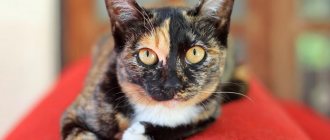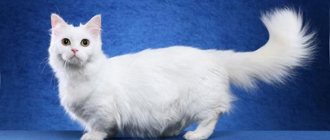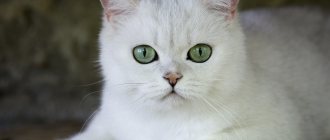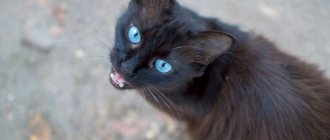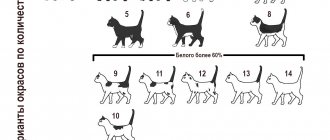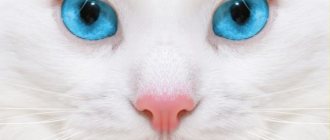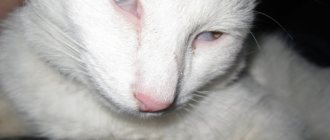The phenomenon of different eyes
Variegated eyes as a phenomenon has a scientific name - heterochromia (from the Greek heteros - “different”, chromos - “color”). Heterochromia, different pigmentation of the iris, results from varying concentrations of the pigment melanin and occurs in both animals and humans. Gender does not matter in this case, although according to statistics, females with this phenomenon are more common.
Heterochromia is often inherited and does not affect visual acuity in any way. The most common combination of different eyes is blue and brown; in felinology it is called copper.
Why can a cat's eyes be different colors?
The debate about why cats have different colored eyes continues. Some consider this to be the result of crossing different breeds, others as an anomaly, and still others as a genetic gift. The issue has not been fully studied scientifically. It is known for sure that this feature is innate. It does not affect visual acuity and does not interfere with animals in any way.
Heterochromia is more common in white cats. They are the fruit of selection; in nature, representatives of the cat family do not have pure white hair. The body of such individuals contains the W gene, which is responsible for the color of the coat. At the same time, there is not enough melanin in it, which affects the shade of the eyes. It turns out that a certain gene is responsible for the color of one eye, and a lack of pigment is responsible for the other.
Sometimes different colored eyes are an acquired phenomenon. The color of the iris may change:
- in case of mechanical injury;
- after inflammatory processes;
- for oncology;
- during long-term treatment with potent drugs.
Heterochromia appears in a combination of blue with green, brown or yellow (see photo). In this case, it can be complete (the eyes differ in color) or partial (several shades/colors are combined in one eye). In the second case, the color is ring or sector.
Turkish Angora
Another cat breed with different eye colors is the Turkish Angora. This animal is small in size, has small bones, and has a long body with round ribs. The weight of the animal is on average 5 kg. Angoras quite often have representatives of the breed with a similar phenomenon. The head has long erect ears. The animal's body may be covered with fur :
- cream;
- white;
- black;
- blue;
- even red.
Felinologists say that this particular breed is the most common white-colored individual with different eyes. These kittens were first bred in Angora, in Byzantium, from which they got their name. Already in the sixteenth century, the breed was brought to continental Europe.
White animals are very popular. They sell them at a higher price. Those individuals purchased from nurseries, as a rule, live longer - approximately 18-20 years.
To ensure that Angora does not get sick, is active and mobile, it is recommended to include food with biological additives in her food. The animal must be brushed regularly. She also urgently needs her ears cleaned and her nails trimmed.
Angoras have an active temperament. They simply love to be the center of attention, are excellent at training, and love physical activity. So smart that they can learn simple tricks. Photos of such an animal will decorate any photo album.
There is no single specially bred cat breed with eyes of different colors. This feature, despite its rarity, is found in many species of animals, the list of colors of which includes white. Some people inherit this genetic mutation of cells, while others acquire it as a result of some disease. However, there are several breeds for which heterochromia is most typical.
This unique phenomenon is called heterochromia and occurs not only in cats, but also in other animals and even in humans. Scientists have not yet fully figured out the reasons for its appearance. Today, there are several factors that influence different eye shades in animals:
- 1. Lack or excess of melanin pigment, which is responsible for the color of the iris, color of the animal’s fur and skin. The color tone of the iris depends on the concentration of this substance and the uniformity of its distribution.
- 2. White-haired gene W. Some cats carry the white-hair gene in their DNA from generation to generation, and with it a genetic predisposition to different-colored eyes. It is worth noting that these genetic mutations can appear in absolutely any individual, regardless of breed. This gene also carries the risk of death of the offspring in the womb.
- 3. Presence of diseases. Very often, heterochromia occurs in animals prone to cancer, leukemia, etc.)
It is worth noting that multi-colored eyes are found not only in completely or partially white cats, but also in black, tortoiseshell, or animals of other colors. Variations in eye colors are also different. The most common combination is yellow and blue, but there can also be blue with gold, green, brown, orange, etc. The following varieties of this anomaly are distinguished:
- Partial. With it, not the entire iris is painted in different colors, but only certain parts of it.
- Full. When each eye has its own color.
- Congenital. Caused by a hereditary mutation.
- Acquired. Occurs due to the presence of any disease and long-term use of medications.
Interestingly, about 30% of cats diagnosed with heterochromia are deaf and have severe hearing problems. Usually this is complete or partial deafness in one or both ears. In addition, breeds that are characterized by this mutation require special care, since they have a tendency to cancer and are not recommended to spend long periods in the sun. According to statistics, pure white kittens live shorter lives than cats of other colors.
Cat breeds with different eyes have always attracted special attention. Some consider them mystical creatures, while others love their pets without attaching much importance to the color of their eyes, just for who they are.
Different eye colors are usually found in completely or partially white cats, but there are colored and black animals with heterochromia. This feature is a consequence of a lack or excess of melanin pigment, which also affects the color of the animal’s coat and skin.
Heterochromia occurs in humans, but is much more common in cats. Moreover, one eye is blue, and the other can be orange, yellow or green. This feature often indicates existing health problems, for example, deafness, but this is not the rule.
What is heterochromia
Heterochromia is a phenomenon in which there is a difference in the color of the iris of the right and left eyes. This phenomenon exists in two variations:
- complete heterochromia - eyes of different colors;
- partial - segments of the iris of one of the eyes differ.
With partial heterochromia, one eye is colored two different colors
The phenomenon of heterochromia in representatives of the cat family is not uncommon. Such animals fully retain their visual functions. The most common manifestation of the deviation is complete heterochromia. One of the eyes may be green, yellow or orange, while the other is only blue.
Melanin, or rather, its lack, is responsible for the heavenly color of the cornea. Odd-eyed cats are predominantly white in color. Similar manifestations also occur in colorful animals, but they are rare.
Heterochromia in cats is a common occurrence, but in cats of different colors (not white in color) it is much less common.
Causes
Today, the causes of heterochromia in a particular individual are not fully understood. There is ongoing debate about whether this is a mutation or a gift of nature. However, different eye colors do not in any way interfere with a cat’s vision and the development of the animal as a whole.
Heterochromia is a congenital phenomenon. However, the color of one of the eyes may change due to:
- the injury received;
- previous illness of inflammatory etiology;
- problems with ophthalmology;
- presence of cancer;
- long-term treatment with medications.
I had the most ordinary kitten, gray-striped in appearance. The color of the eyes, like all babies, was a dull gray-blue. When he learned to crawl, he began to actively explore the surroundings of his box. And then one night I woke up from a plaintive “meowing”. It turned out that the kitten had moved into the dog’s territory, and the dog decided to play with it. The dog only licked the small furry creature, but to the kitten it looked like a real monster. Of course, he was selected, washed of drool and delivered to his mother cat. And a week later, I noticed that the baby’s eye color had become different: greenish-yellow in one and sky blue in the other. We still don’t understand what this is connected with, but we think that the cause could well be trauma from too much love from our dog. The kitten has grown up, hears and sees perfectly, but his different eyes always attract the attention of all our guests. It looks really unusual.
Beauty and deafness
Unusual beauty has a downside - many heterochromic animals have serious hearing problems.
Alas, cats with different eyes are often deaf - completely or partially. Moreover, in the latter case, the ear located on the side of the blue eye usually does not hear. The reason for this deafness is genetic, it is the result of the action of the white color gene W.
Its dominant allele blocks not only the production of color pigment, but also the development of hearing aid cells. Fortunately, breeders are resisting, and quite successfully, the spread of deafness of this kind in the population.
Deafness
According to statistics, white cats with blue eyes suffer from hearing problems. Deafness can be complete or partial. This is due to degeneration of the inner ear. But pure white cats with green and yellow eyes have normal hearing.
A white cat with blue eyes most often has hearing problems
If a cat has heterochromia and one of the eyes is blue, then her ear will not hear on that side. This feature of albinos has been studied since the beginning of the 19th century. Many researchers subsequently found a direct relationship between white coat color, blue eyes and lack of hearing.
Deafness in cats with white fur and blue eyes occurs due to abnormalities in the genetic code. The “white” gene dominates, influencing the process of formation of the animal even in the embryonic state. This has been proven experimentally.
A 1997 study examined cats with varying degrees of hearing loss. 72% of the cats examined were deaf. It was discovered that the organ of Corti degenerated completely within the first few weeks after birth. But even during these first weeks, auditory stimuli did not elicit a response in the brainstem, suggesting that these animals had never experienced sound sensations. It was also found that several months after the degeneration of the organ of Corti, the nerve cells of the cochlea of the inner ear began to degenerate.
The primary formation of the analysis of sound signals begins in the Organ of Corti
https://www.sciencedirect.com/science/article/pii/S0378595597001822?via%3Dihub
A white kitten with blue eyes will not necessarily be deaf. It is necessary to trace the pedigree: if among his ancestors there were Siamese cats or Thais, then the blue color of the eyes is due to heredity, and not pathology.
Features of care
There is no need to take any mandatory measures to care for cats with different-colored eyes, the only thing is to pay attention to the nitrous oxide that has accumulated in the inner corner of the eye; if there is a lot of it and it is purulent, it’s time to see a veterinarian.
As for the snow-white coat, during the molting period it must be combed with a furminator, and the purr needs to be accustomed to the procedure from early childhood. It is better to put the slicker aside, otherwise the cat will lose its natural source of heat. If the coat is too long and tangles form, trimming will help in the summer.
There are many varieties of cats, cats and kittens with different eyes, so it is worth familiarizing yourself with the information presented in this article to get a complete understanding of them and their features.
The article will discuss the most famous representatives of the breed, which have these characteristics, and will provide answers to frequently asked questions about them and their name, as well as recommendations for care and feeding.
Cats with different eyes breed, character
Angora cats have different colored eyes. Ethologists claim that such animals have just as changeable moods, are unpredictable and more capricious than cats with the same eye color.
Cat breed with sad eyes, sad cat from China
Most likely we are talking about a representative of an exotic shorthair cat breed, namely a cat named Snoopy. His photographs posted on the Internet made the kitten with big sad eyes popular not only in China, but throughout the world.
The cat with sad eyes from the cartoon Shrek, Snoopy
When you see sad cat eyes in cartoons about Shrek or Leopold, it is taken for granted. It's another matter when you encounter a cat with sad eyes in life. And it is not as rare as it might seem. Expressions of sadness can often be seen in exotic, Persian and Scottish cats. Thus, it was thanks to his irresistible look that a cat named Snoopy won hearts and gained more than a thousand views from Internet users.
Breed of cats with sad eyes and short legs name of the breed
Cats with sad eyes and short, dachshund-like legs belong to the Munchkin
. The breed arose as a result of natural mutation, and not through targeted selection.
White cat with huge different eyes, what is the breed called?
Off the coast of Turkey you can see a local landmark - a large sculpture of a white cat with huge eyes. The image of the immortalized mustachioed fluffy did not arise in the imagination of the sculptor. Such an animal also exists in nature. The breed is called Turkish Van. Cats of this breed are famous for their unusual multi-colored eyes and ability to swim.
Cats with different eyes care and feeding, price
Caring for and feeding cats with different eyes is no different from caring for any other domestic cat, but the price for such animals can be exorbitant. Especially if the animal belongs to the Turkish Van, Kao-mani or Turkish Angora breed.
Are cats with different eyes deaf or not and why?
Deafness in white cats with different eyes is genetic. It is determined by the dominant allele of the gene. This connection was noticed by Darwin.
Cats with different mystic eyes, signs, magical properties
Cats. Many folk signs, rituals and fortune telling are associated with them. These animals are equally deified and considered the offspring of the devil.
Thus, an ordinary black cat in Great Britain is considered a symbol of good luck, but here “they say it will be unlucky if a black cat crosses the road.”
Also cats with different eyes. In some nations, these cats are shunned (even to the point of physical harm), while in others they are revered and cherished, believing that such unusual creatures can bring prosperity and happiness to the home.
Be that as it may, looking straight into a cat's eyes is not recommended. An animal may perceive such a look as a challenge and rush at a person.
Dream Interpretation: dream of a cat with different eyes, what does this mean
In most cases, a dream about cats is interpreted as an unfavorable sign, warning of intrigues and betrayal. However, if the cat in the dream had different eyes, then the dreamer will be able to learn a positive lesson from an unpleasant situation for him.
Cat with different eyes character
Most owners of cats with different eye colors note the unpredictability in the character of their pets. However, if you properly raise the adopted animal, then no special incidents will arise. These are the same cats who love affection and respond in kind to love from humans.
It has long been believed that cats with different eyes bring good luck to their owners. Scientists have debated for years what accounts for this unique and sometimes downright frightening sight. Some claimed that it was a genetic mutation, others were sure that it was some kind of disease. Today we will try to understand the reasons for this phenomenon and find out what breeds of cats it is inherent in.
A special breed?
Not only purebred cats can be heterochromic; this phenomenon is also observed in outbred animals. Many people mistakenly think that a white cat or a white cat with different eyes are representatives of some special breed. Indeed, among representatives of some breeds, for example, Turkish Van, Turkish Angora or Kao Mani, heterochromic individuals are very common.
But the British, the Scots, the Persians, the Maine Coons, the Rexes, and the most ordinary yard cats can all have different eyes. For example, the world-famous snow-white beauties with different eyes, Iris and Abis from St. Petersburg, are mongrel.
Turkish Angora
These small animals, distinguished by small bones, have an elegant elongated body with rounded ribs. The average weight of an adult is about five kilograms.
Among the representatives of this breed there are also cats with different eyes. The wedge-shaped head of the animal is decorated with large erect ears covered with soft hair. The body of the Turkish Angora is covered with silky hair that is white, cream, black, blue or red. Individuals of the Himalayan, lilac and chocolate colors are not allowed for breeding.
White Angora cats with different eye colors are especially popular. They are usually sold at a higher price. Individuals purchased from a professional nursery do not have hereditary diseases and can live for at least eighteen years.
The basis of the Turkish Angora's diet should be special super-premium food. Coat care boils down to regular brushing with a brush. It is enough to repeat this procedure once a week. Representatives of this breed also require regular ear cleaning, nail trimming, and eye rubbing.
These rather playful cats have an active temperament. They love physical activity and love to be the center of attention. To prevent your pet from getting bored during your long absence, it is advisable to purchase a scratching post, special exercise equipment, interactive toys and other accessories that allow the animal to splash out its accumulated energy. In addition, the Turkish Angora is highly trainable. She is so smart that she is quite capable of mastering several not too difficult tricks.
White color is always symbolized with something pure, light and immaculate. Therefore, cats that have this color always look gallant or royal. Moreover, their often pink nose, inner ear and pads add cuteness against such a clean background.
It is impossible not to notice if a white cat has multi-colored eyes. In this article we will discuss what breeds of just such cats there are, and how they differ.
Breeds that may have heterochromia
Not all cats with white fur experience this phenomenon, and its occurrence is 100% impossible to predict. Breeders tried to breed a separate breed, but they failed. Of particular value are those babies in whom heterochromia has been observed in several generations. This is possible in Turkish Vans, Angora cats and representatives of the Kao-Mani breed.
Turkish Angora
The breed got its name from the Byzantine city of Angora, which is its homeland. These cats came to Europe in the 16th century. There is an opinion that it is its representatives who are most predisposed to heterochromia. Most Angora cats have white fur, less often marbled or creamy. However, you can find individuals of black, red or even blue color.
This is an elegant medium-sized animal, weighing about 4 kg. Has long erect ears. The coat is almost without undercoat, but is delicate, soft and fluffy. The disadvantage of the breed is considered to be a tendency to hearing loss.
The cat has a calm and docile character, gets along well with other pets, and is very attached to its owner.
Turkish van
The breed is named after the region of Turkey in which it was created. Individuals of this breed are quite large in size. The wool is not very long, but soft and pleasant to the touch. The color can be not only white; there are animals of various colors: tortoiseshell, with red, black, gray markings.
These cats are very playful and active, they have a well-developed hunting instinct. The Turkish Van is distinguished by its curiosity and sociability, and considers only one person to be its owner. Contrary to the well-known opinion that cats do not like to bathe, representatives of this breed do it with pleasure.
They are also easy to train and quickly learn simple commands.
There are breeds of cats for which heterochromia is not a pattern, but rather occurs as an exception. Animals are born albinos, and different colors of the irises of the eyes are a secondary sign of a genetic deviation. Heterochromia is extremely rare in the following breeds:
- British shorthair;
- Scottish Scottish or Highland;
- orientals;
- Persian cats;
- Maine Coons;
- Canadian Sphynxes;
- Devon Rex;
- Cornish Rex.
Khao mani
The breed originates from Thailand and was bred for the royal family. Even now, not everyone can afford to buy such a kitten because of its high price. The name translates as “diamond eye” or “white pearl”. It was believed that a white cat with different eyes attracts happiness, prosperity and good luck to the home. Therefore, even in the modern world, kao mani is treated with awe and adoration.
The animals are small in size and have short, silky fur. The slightly elongated muzzle, combined with a pink nose, makes the cat funny and cute. Some Khao Mani kittens are born with multi-colored spots, but as the individual grows older, the markings completely disappear. Cats of this breed are friendly and sociable, require constant attention from the owner and are afraid of loneliness.
Persian cat
Persians are considered the most common cats in the world. Since they come in different colors, the white ones with different colored eyes are a really great find. However, for such a find you need to pay twice as much.
Of course, it also happens that heterochromia occurs in other breeds, but this is more often explained by the fact that this has occurred to some extent as a gene mutation. Therefore, if you want to buy a white cat with different eyes, we advise you to choose one of the breeds listed in this article, or you can see what kind of white cat with blue eyes there is from several breeds.
Turkish Van
This breed of cats with different eyes is not very famous in Europe and is popular only in Turkey itself and some Asian countries. The Turkish district of Van is the birthplace of these beautiful white animals, which is why they were given this name.
One of the main features of the Turkish Van is the color of the iris . As a rule, the eyes have complete heterochromia - one eye is blue, and the other is orange or amber. Cats of this breed have soft and silky fur. Despite the fact that they are quite fluffy in appearance, cats of this breed do not have particularly long hairs. Turkish Vans are quite smart and easily amenable to simple training techniques. Even at home.
Cats of this breed are playful and love various pranks. They can find their own entertainment in the house. For example, a high point will be a peak that they will constantly conquer. By nature they are hunters, so they are not at all afraid of bodies of water. Thanks to this feature, the bathing process will only bring pleasure to both the animal itself and its owners.
Another white cat with different eyes is Khao Mani. Kittens of this breed are commonly called “diamond eyes.” This breed of cat was bred in Thailand by order of the royal families, so the price of Khao Mani is quite high, and not everyone can buy it. This is especially true for representatives of the breed with different eyes. Thais are convinced that an odd-eyed cat can bring wealth, good luck and peace with tranquility to the house.
Khao Mani are short-haired cats with a small body size . Their main feature is the fear of loneliness, so they are extremely active and friendly. Cleanliness is also a hallmark of this breed, making them easy to care for.
Are there such representatives among other breeds or outbreds?
Scottish Fold Cat
In the listed breeds, heterochromia is more common, but in other animals the appearance of this feature is also possible. Kittens with different colored eyes are found among:
- Scots;
- British Shorthair;
- Canadian sphinxes;
- Maine Coons;
- Persian cats.
Even a mongrel pet may have different eyes; they will be caused by a genetic mutation or changes that have occurred during life. From an esoteric point of view, such cats are considered carriers of pure energy and good luck, and therefore are highly valued.
Health of cats with heterochromia
Owners of pets with different-colored eyes need to remember the following nuances of furry health:
- If a blue eye suddenly turns red, your cat most likely has a bruise. The veterinarian will diagnose a broken vessel or hematoma, which should only be treated under the supervision of an experienced doctor.
- The color of the eye can change if melanoma grows or another neoplasm appears, a tumor located in the eyeball or fundus. Not every veterinarian is able to make an accurate diagnosis, so if you do not trust one doctor, consider him insufficiently competent, and the treatment does not give visible positive results, do not be afraid to consult another veterinarian.
Content Rules
Most often, cats with heterochromia do not require special care or special conditions. They, like cats of any other breed, are taught routine and order from early childhood. Eating, resting and outdoor games should occur at a certain time. The kitten gets used to the established rhythm of life, which contributes to a mutually comfortable pastime.
An important factor is toilet training the animal. Kittens learn this from their mother by observing and inheriting her actions. If you have acquired a very tiny fluffy, you will have to take care of his good habits yourself. The pet must be placed in a tray with litter immediately after feeding. Purebred kittens are very smart and clean, so they quickly get used to relieving themselves in a certain place.
It is important that the tray is located in an accessible and safe place.
Kittens are naturally active and playful, but you don't always have time to have fun with them. The consequences of independent cat games can be torn curtains, torn wallpaper or furniture. To prevent this from happening, it is necessary to accustom the animal to the right games. First of all, you need to buy or build a scratching post for your pet yourself. From the many toys in the pet store, you are sure to choose something useful and attractive for your cat.
Despite the innate cleanliness and neatness, sooner or later the cat will have to be bathed. This procedure will be especially relevant for animals with white and long fur. It is necessary to accustom a kitten to water procedures from early childhood, then the process of adaptation will be quick and painless. The water should be at a comfortable temperature - about 30 degrees; only special shampoo can be used as a detergent. For long-haired breeds, it is advisable to use conditioner to prevent tangling and electrification of the coat.
A cat, being in a limited habitat, needs proper and balanced nutrition, which you must provide it with. It is very convenient to feed the animal with ready-made dry or wet food. To make the right choice, just consult a veterinarian and carefully read the instructions on the package. A prerequisite is compliance with the recommended dosage of food. If you think that your cat deserves exclusively fresh and natural products, then get ready to diversify his menu with products such as:
- fish;
- meat;
- dairy products;
- cereals;
- vegetables.
When composing your pet’s diet, you should take into account the breed, age, gender of the animal, health status, and even the time of year and temperature of the food. To keep cats comfortable at home, you need to take into account their physiological characteristics. If you do not plan to breed animals, then for convenience and your own peace of mind, it is recommended to sterilize them. This simple surgical procedure is performed in a veterinary clinic.
Sterilization has a positive effect on the character and behavior of the cat and even helps prevent certain diseases.
Save and increase
For a hundred years now, the Ankara Zoo has been running a program to breed white Angora cats with different or blue eyes.
At the beginning of the last century, unusual Angora cats found themselves in danger of extinction: the gene for long hair was actively used in the development of new breeds, and there were catastrophically few purebred Angoras left. In 1917, Turkey decided to preserve the breed as a national treasure, and for some time local animals were even prohibited from being exported abroad.
Now other white cats with different-colored eyes are bred in the world - and the British Shorthair breed is not lagging behind in this. For example, a nursery for odd-eyed Britons operates in Rotterdam.
